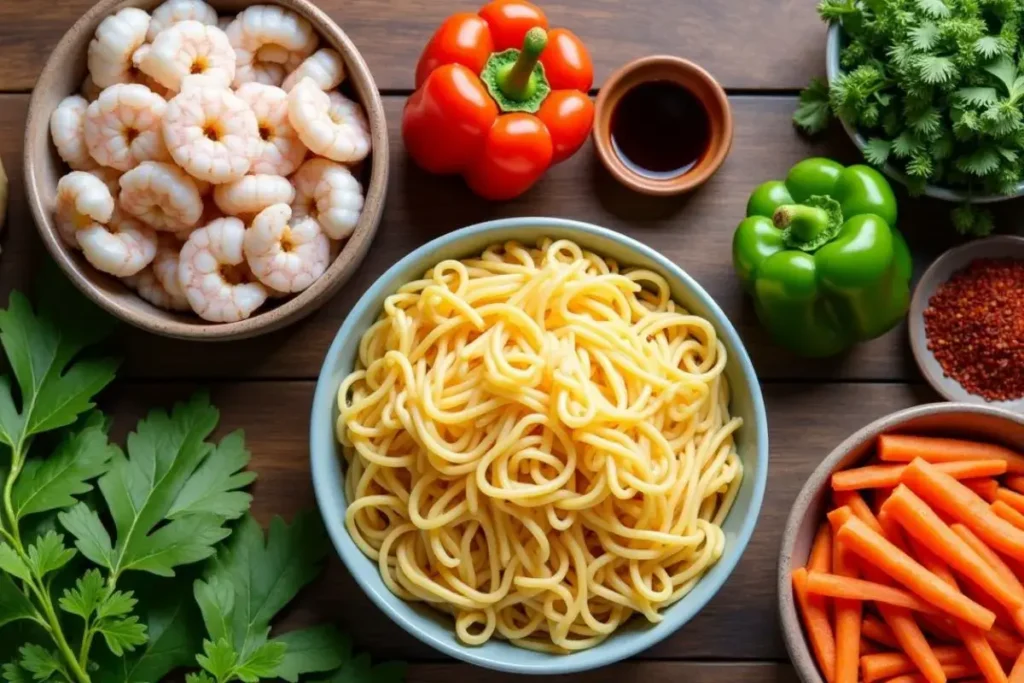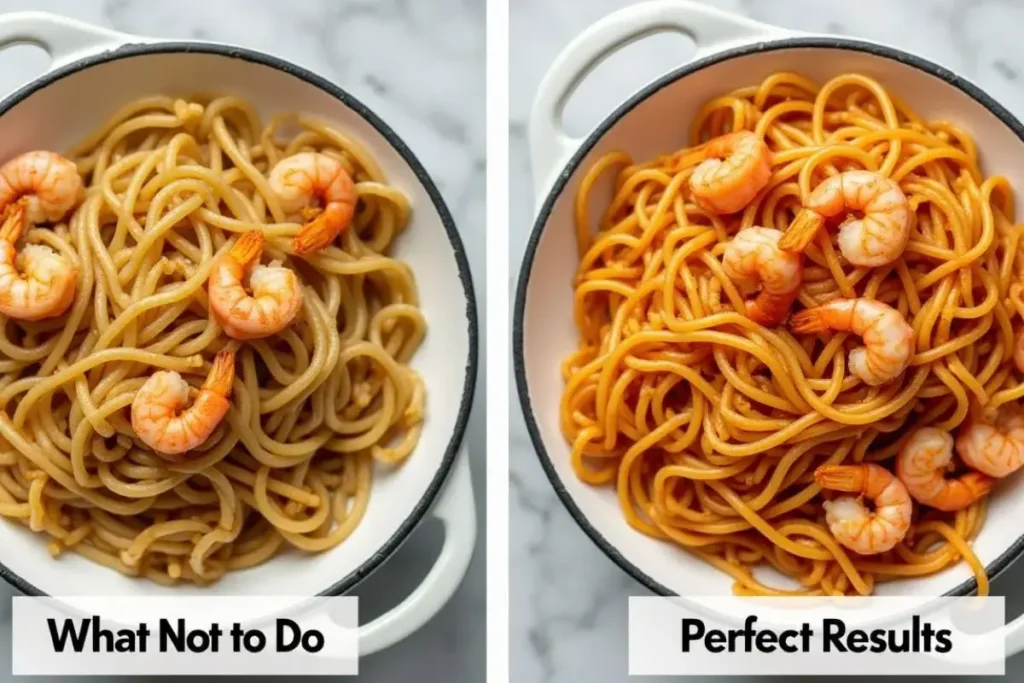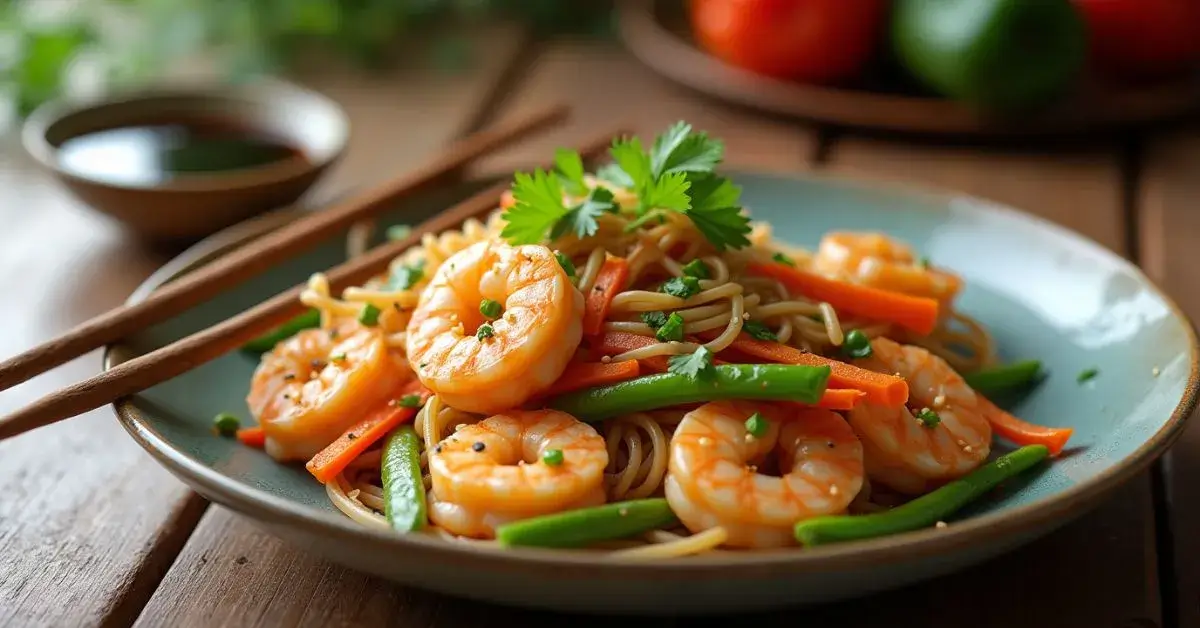Asian-Inspired Shrimp and Noodles Recipe You’ll Love
Table of Contents
Get ready to enjoy a delicious shrimp and noodles recipe that captures the essence of Asian cuisine. This dish combines flavors, textures, and aromas that take you on a journey to Asia. It’s a must-try for anyone who loves food, thanks to its rich cultural background and varied regional flavors.
Exploring Asian-inspired shrimp and noodles recipes opens up a world of ingredients and cooking methods. You’ll find everything from spicy Korean chili flakes to the sweet taste of Japanese soy sauce. Whether you’re an experienced cook or just starting out, this recipe will amaze you and make you want more.
Key Takeaways
- Asian-inspired cuisine offers a diverse range of flavors and textures to explore
- Shrimp and noodles recipe is a classic combination that can be customized to suit your taste
- Regional variations and cultural significance add depth and richness to the dish
- Experimenting with different ingredients and cooking techniques can elevate the recipe
- Asian-inspired shrimp and noodles recipe is perfect for special occasions or everyday meals
The Story Behind Asian Shrimp and Noodle Dishes
Exploring Asian cuisine, you’ll find shrimp and noodles are key in many dishes. This combo’s history and regional twists add to its cultural value. From Korea’s spicy kimchi to Japan’s light ramen, each country puts its own spin on it.
In Asian cooking, shrimp and noodles come together for a perfect mix. The dish combines juicy shrimp, springy noodles, and rich sauces. Enjoying a Vietnamese pho or Thai pad thai, you’ll see its cultural importance.
Cultural Significance in Asian Cuisine
Shrimp and noodles hold a special place in Asian traditions. They’re central to family meals and special events. Serving them at weddings and holidays brings good luck and prosperity.
Regional Variations Across Asia
Asia’s shrimp and noodle dishes vary greatly. India’s curries and China’s soups are just the start. Korea’s kimchi stir-fries and Japan’s tempura show each country’s unique flavor.
Evolution of the Dish in American Kitchens
As Asian food grows in the US, shrimp and noodles adapt. You’ll find stir-fries and traditional dishes like pad thai and pho. The dish’s cultural value remains, even as it evolves.
Essential Ingredients for Your Shrimp and Noodles Recipe
Creating a tasty shrimp and noodles dish starts with the right ingredients. You need a mix of shrimp and noodles that taste great together. For an Asian twist, you’ll want various noodles, proteins, veggies, and seasonings.
First, pick the perfect noodles for your dish. You might choose rice noodles, egg noodles, or another Asian noodle. Next, get fresh, tasty shrimp from seafood markets or stores. Don’t forget to add veggies like bell peppers, carrots, and snow peas.
Other must-haves include soy sauce, garlic, ginger, and sesame oil. These add flavor and are key in Asian cooking. For a spicy kick, try red pepper flakes or sriracha. Mixing these ingredients well will make a delicious shrimp and noodles dish for any event.

Here are some key ingredients to keep in mind:
- Noodles (rice, egg, or other Asian-inspired types)
- Shrimp (fresh and flavorful)
- Vegetables (bell peppers, carrots, snow peas, etc.)
- Soy sauce
- Garlic
- Ginger
- Sesame oil
- Red pepper flakes or sriracha sauce (optional)
Choosing the Perfect Noodles for Your Dish
Choosing the right noodles is key for a tasty shrimp and noodles dish. You can pick from rice noodles or egg noodles. Each has its own special qualities, so knowing the differences is important.
Rice noodles are a favorite for Asian dishes and go great with shrimp. They’re soft and made from rice flour. Egg noodles, on the other hand, are chewier and made from wheat flour and eggs. Your choice depends on what you like best.
Noodle Texture and Flavor
Think about the texture and flavor you want in your dish. Fresh noodles are softer and have a lighter taste. Dried noodles last longer and can be just as tasty.
Best Noodle Substitutes
Looking for other noodle options? Try glass noodles, udon noodles, or soba noodles. They bring different textures and tastes to your dish, replacing rice or egg noodles.
Here’s a quick guide to noodle options:
| Noodle Type | Texture | Flavor |
|---|---|---|
| Rice Noodles | Soft and delicate | Mild and slightly sweet |
| Egg Noodles | Chewy and firm | Richer and more savory |
| Glass Noodles | Transparent and gelatinous | Mild and slightly sweet |
Selecting and Preparing Fresh Shrimp
For a tasty spaghetti & shrimp dish, fresh shrimp are key. Preparing them right means they’re clean, safe, and full of flavor. Look for whiteleg shrimp or giant tiger prawns for their sweet taste and firm texture.
To get your shrimp ready, rinse them under cold water. Then, dry them with a paper towel. Next, make a shallow cut along the top to remove the vein. This makes the shrimp safer and look better.
Here are some tips for selecting and preparing fresh shrimp:
- Choose shrimp with a sweet smell and firm texture
- Avoid shrimp with a strong fishy smell or soft texture
- Rinse the shrimp under cold water before preparing
- Pat the shrimp dry with a paper towel to remove excess moisture
By following these steps and tips, you can ensure that your fresh shrimp are prepared safely and deliciously. They’re now ready to be added to your favorite spaghetti & shrimp recipe.
| Shrimp Type | Taste | Texture |
|---|---|---|
| Whiteleg Shrimp | Sweet | Firm |
| Giant Tiger Prawns | Sweet | Firm |
Must-Have Asian Sauces and Seasonings
When cooking Asian-inspired dishes, the right sauces and seasonings are key. They add depth and a burst of flavor to your shrimp and noodles. You can find these at your local grocery store or Asian market.
Essential sauces include soy sauce, oyster sauce, and hoisin sauce. Use them to marinate shrimp, flavor noodles, or as a dipping sauce. Try mixing different sauces and seasonings for a unique taste.
Traditional Sauce Components
Traditional Asian sauces blend soybeans, garlic, ginger, and chili peppers. These ingredients ferment to create a rich, savory sauce. It’s full of umami flavor.
Flavor-Enhancing Spices
There are many spices that enhance flavor. Chinese five-spice, curry powder, and sesame oil are popular. Use them to flavor shrimp, noodles, or vegetables.
Storage Tips for Asian Condiments
Proper storage keeps your sauces and seasonings fresh. Most can be stored in the pantry or fridge. Always check the label for storage instructions to keep them tasting great.
Step-by-Step Shrimp and Noodles Recipe
To make a tasty shrimp and noodles dish, follow this easy guide. First, cook your noodles as the package says. While they cook, heat some oil in a pan and toss in your favorite veggies like bell peppers and carrots.
Then, add the shrimp to the pan and cook until they turn pink. Next, add your favorite sauce, like soy or oyster sauce, and mix well. Once the noodles are ready, drain them and toss them with the shrimp and sauce in the pan.

- Use fresh and high-quality ingredients for the best taste.
- Avoid overcooking the noodles or shrimp to prevent them from becoming tough.
- Try different sauces and seasonings to find your favorite mix.
By following this guide, you can make a delicious shrimp and noodles dish. It’s sure to be a hit with everyone. With a bit of practice, you’ll be making this recipe like a pro in no time.
Mastering the Proper Cooking Techniques
To get the perfect texture and flavor in your shrimp and noodles dish, you need to master the right cooking techniques. This includes knowing the best ways to cook noodles and shrimp. Also, understanding the benefits of using a wok versus a pan is key.
Proper Noodle Cooking Methods
Cooking noodles is a vital step in making your dish. You can boil, steam, or stir-fry them. The goal is to cook them until they’re tender but still firm. If you overcook them, they’ll become mushy and unappetizing.
Perfect Shrimp Cooking Times
Cooking shrimp right is important to avoid overcooking. The cooking time depends on the shrimp’s size and the method. Usually, cook them for 2-3 minutes on each side. They should turn pink and not be translucent anymore.
Wok vs. Pan Cooking Tips
For cooking your shrimp and noodles, you can use a wok or a pan. A wok is great for stir-frying because it cooks food quickly and evenly. A pan is better for methods that need more heat control, like sautéing or boiling.
Common Mistakes to Avoid When Making Asian Noodles
When cooking Asian noodles, like spaghetti & shrimp, it’s easy to make mistakes. One big error is overcooking the noodles, making them mushy. To fix this, check the cooking time and drain the noodles when they’re still firm.
Another mistake is using low-quality ingredients. This can ruin the flavor and texture of your dish. When making spaghetti & shrimp, use fresh and high-quality ingredients for the best taste.

Here are some common mistakes to watch out for:
- Not balancing the flavors, resulting in a dish that’s too salty or too bland
- Not cooking the shrimp properly, leading to tough or undercooked shrimp
- Not using the right type of noodles for the dish, which can affect the texture and flavor
By knowing these common mistakes, you can avoid them and make a delicious Asian noodle dish with spaghetti & shrimp.
Remember, practice makes perfect, so don’t be discouraged if your first attempts at making Asian noodles don’t turn out as expected. Keep trying, and you’ll soon become a master of this delicious and versatile dish.
Delicious Variations of the Basic Recipe
Once you get the hang of the basic shrimp and noodles recipe, you can try out different variations. You can make it spicy by adding red pepper flakes or sriracha sauce. This gives the dish a bold kick, perfect for those who like a bit of heat.
You can also add vegetables like bell peppers, carrots, or snap peas. These not only make the dish look good but also add freshness and flavor. Try using chicken or tofu instead of shrimp for a new twist on the classic recipe.
- Adding sliced mushrooms for an earthy flavor
- Incorporating chopped cilantro for a fresh and herbal taste
- Using different types of noodles, such as rice noodles or udon noodles, for a varied texture
By trying out these variations, you can make a dish that’s all your own. It’s a great way to enjoy your favorite flavors in a new way.
Pairing Suggestions and Side Dishes
Enjoying Asian-inspired cuisine is even better with the right pairings and side dishes. You can pair your shrimp and noodles with stir-fried veggies, pickled ginger, and steamed dumplings. These options add flavor and texture, making your meal complete.
Some great pairings for Asian dishes include:
- Stir-fried veggies like broccoli, bell peppers, and carrots
- Pickled ginger for a tangy and refreshing taste
- Steamed dumplings filled with pork, chicken, or veggies
- Fried wontons as a crispy and savory side
Think about your shrimp and noodles recipe when picking sides. For example, if it has soy sauce and ginger, try steamed edamame or stir-fried bok choy. This way, you’ll have a meal that’s both delicious and well-balanced.
Creating a great Asian-inspired meal is all about balance. With the right pairings and sides, you’ll enjoy a meal that’s both tasty and satisfying. It’s a true showcase of Asian cuisine’s best.
Storage and Reheating Guidelines
To keep your shrimp and noodles dish fresh and safe, follow these storage and reheating tips. Store it in a covered container in the fridge at 40°F (4°C) or below. This stops bacteria from growing and keeps your dish fresh longer.
For longer storage, freeze the dish. Freezing saves the texture and flavor of shrimp and noodles. To reheat, steam or microwave. Steaming keeps moisture in, while microwaving is quick. Always reheat safely to avoid illness.
Proper Storage Methods
- Refrigerate at 40°F (4°C) or below
- Freeze for longer storage
- Use airtight containers to prevent moisture and other flavors from affecting the dish
Best Reheating Practices
- Steam the dish to preserve moisture and flavor
- Microwave safely by covering the dish and heating it in short intervals
- Check the temperature of the dish to ensure it reaches 165°F (74°C) to prevent foodborne illness
By sticking to these storage and reheating tips, you can enjoy your shrimp and noodles safely. Always check for spoilage before eating. If it smells bad, looks slimy, or has mold, throw it away.
Conclusion: Mastering Your Asian-Inspired Shrimp and Noodles
Learning to make the perfect shrimp and noodles recipe is like mastering an art. It combines the deep flavors of Asian cuisine. You now know the key ingredients, cooking techniques, and tasty variations to make delicious Asian-inspired dishes at home.
Feel free to try out different spaghetti & shrimp mixes. Experiment with spices, veggies, and proteins. This recipe’s flexibility lets you add your own twist, creating new flavors that excite your taste buds.
Mastering shrimp and noodles is a journey, not a one-time task. Keep learning and improving your skills. With each dish, you’ll grow more confident and appreciate Asian cooking even more.
Let your creativity in the kitchen flourish. Enjoy making your own unique Asian-inspired shrimp and noodles recipe. Bon appétit!
FAQ
What is the cultural significance of Asian shrimp and noodle dishes?
Asian shrimp and noodle dishes are deeply valued in many cultures. They show the rich flavors and cooking traditions of different areas in Asia.
What are the key ingredients for an Asian-inspired shrimp and noodles recipe?
For an Asian-inspired shrimp and noodles dish, you need noodles like rice or egg noodles. Add fresh shrimp, veggies like bell peppers, and a sauce with soy sauce, fish sauce, and spices.
How do I choose the perfect noodles for my shrimp and noodles dish?
Choosing the right noodles is key. Think about texture, cooking time, and flavor. Rice and egg noodles are good choices. Pick fresh or dried based on what you like and can find.
What are some tips for selecting and preparing fresh shrimp?
Choose plump, firm, and smell-free shrimp. Clean and devein them well. Keep them fresh by storing in the fridge or freezer and handling carefully.
What are the must-have Asian sauces and seasonings for this recipe?
For shrimp and noodles, use soy sauce, fish sauce, and rice vinegar. Don’t forget sesame oil, garlic, ginger, and chili peppers. These give the dish its bold flavors.
What are some common mistakes to avoid when making Asian noodles?
Avoid overcooking noodles and using low-quality ingredients. Also, make sure flavors are balanced. Use the right cooking times, choose quality ingredients, and adjust seasonings to get it right.
How can I customize the basic shrimp and noodles recipe to suit my preferences?
To customize, add more chili peppers for spice, or try different veggies like broccoli. You can also use chicken or beef instead of shrimp.
What are some tips for storing and reheating leftover shrimp and noodles?
Store leftovers in an airtight container in the fridge for 3-4 days. Reheat gently by steaming or microwaving to keep noodles and shrimp tender.
Did You Love Our Recipe?
There are no reviews yet. Be the first one to write one.

